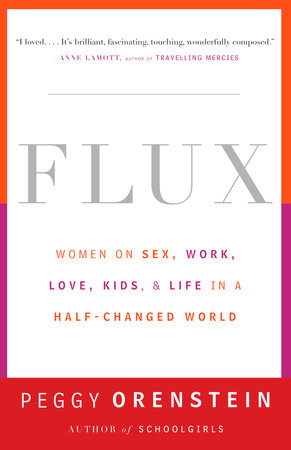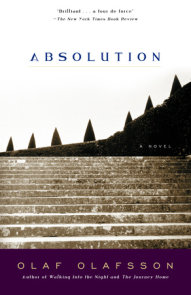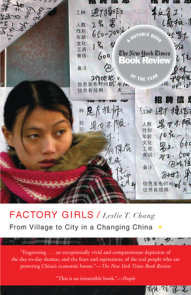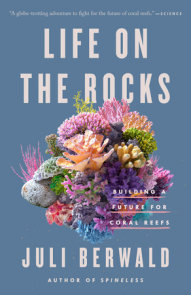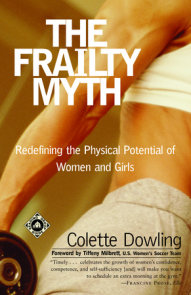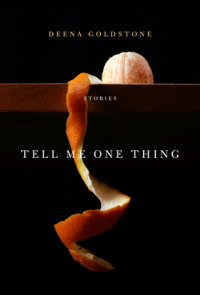READERS GUIDE
"I loved it. . . . It’s brilliant, fascinating, touching, wonderfully composed." –Anne Lamott, author of Traveling MerciesThe questions, author biography, and interview that follow are intended to enhance your group’s discussion of Peggy Orenstein’s Flux, an engaging and illuminating look at the concept of womanhood at the beginning of the twenty-first century.
Introduction
At thirty-four, Peggy Orenstein faced a series of dilemmas shared by many women of her generation: She was unsure whether she wanted children, uncertain what the impact of motherhood would be on her career, her relationships, and her sense of self. Why, when women seemed to have so many choices, did she suddenly feel as if she had none? After feminist liberation and its subsequent backlash, she realized that women’s lives, including her own, were now in a state of flux.After talking to over two hundred women between the ages of twenty-five and forty-five, Orenstein has blended their voices into a compelling narrative that allows the reader to get deep inside the lives and choices of other women and share their thoughts on ambition and power, the experience of sex and love, the meaning of motherhood, what it means to remain single and childless, and how these things influence the way women assemble the pieces of their lives.
For all women who are looking for insight into their lives and the forces that inform them, Flux has the power to inspire discussion and, by illuminating the key conflicts of real women, show how life might be changed. Only Peggy Orenstein, with her narrative gift and unique reportorial skills, could produce such a cutting-edge book, a true blueprint for how women behave at the turn of the century, an indispensable guide for women making important decisions that will affect their entire lives.
Questions and Topics for Discussion
1. Part I: The Promise
Peggy Orenstein has structured her book in a deliberate way: the opening of each section presents a chorus of voices, leading into the solos that anchor chapters. How does this enhance the author’s examination of her subject?
2. Early in the book, one of the author’s subjects wonders "if we’d be happier living in a society where there weren’t so many choices" [p. 17]. Does contemporary society offer women more choices than those available to previous generations? Were our mothers and grandmothers more content than we are today?
3. Throughout the book, women of every age confront the question of working for meaning or working for money. What is the difference? What are the pros and cons of each choice?
4. In Flux, many of the women in their twenties think of marriage as a means to an end–namely, children. Have you ever viewed marriage this way? Do you now?
5. Six female medical students discuss a seminar they’d just attended on balancing work and family [pp. 37‹38]. None of their male classmates came, nor did the women expect them to. What are the implications of the men’s absence on the women’s future careers and personal lives? What can women reasonably expect or demand from men?
6. A corporate double-bind currently exists for women in the workplace: women who are perceived as feminine are considered ultimately ineffective, but those who are seen as too masculine are considered overly aggressive. How can these perceptions be changed?
7. Many of the working women in this book, whether they view themselves as being on the "fast track" or the "mommy track," reportedly feel that it is the women at work who judge them most harshly. Is this true in your experience? If so, why do you think this happens?
8. Part II: The Crunch
Talk about the Crunch years as they relate to your life (or as you expect them to). Do you find that, as the author states, "’You can be anything’ collides with ‘you can’t have it all’" [p. 96]?
9. Do you think more women would be more likely to look at single life as an option and not a sentence if society in general celebrated its ease, rewards, and satisfactions?
10. What role does money play in marriage? Is it the true source of power? Has your marriage ever undergone changes in the balance of power because of a dramatic change in the earning status of you or your spouse? Could you imagine marrying a man who would make less money than you over the long run? What would be the advantages and disadvantages?
11. How can children be "an obstacle to fulfillment rather than its source" [p. 105]? Is the concept of motherhood overly idealized by women?
12. Orenstein notes that women, whatever their arrangements, feel like lesser mothers than those of the previous generation, while men, even with minimal participation at home, feel like better fathers [p. 110]. Do you think this is true? If so, why? What might change this?
13. The author suggestions that "neither a woman’s early childhood experience nor her expectations . . . nor even a feminist orientation can predict how she’ll navigate the choices and constraints of motherhood" [pp. 165-166]. Looking back at your life and the lives of your sisters or close women friends, how do you account for the different choices all of you have made?
14. How does our culture "conspire against egalitarian co-parenting" [p. 173]? What is your response to caretaking fathers when you see them at the mall or the playground? Have you ever treated a caretaking father as less competent than a similar mother?
15. Orenstein comments that women’s endless attempts to be perfect mothers remind her of teenage girls, who, no matter what their weight, see themselves as fat [p. 178]. What does a mother have to do to feel "good enough"? What role does mother management play in what women consider good motherhood?
16. Carrie discusses her expectations for her son and daughter [p. 182]. She would like her daughter to have a career before a family, and be able to choose whether to work or not. But she never imagines her son as a stay-at-home dad. How do you envision your children’s lives? Are we perpetuating inequality in our dreams for our kids?
17. With which women do you identify most and least? Which women had experiences or made choices that were most enlightening to you?
18. Part III: Reconsiderations
Women executives cite pay inequity, old-boy networks, dead-end jobs, and stereotyping as greater obstacles to their careers than motherhood, yet the challenges of motherhood are often the focus when we talk about women in the workplace. Is motherhood helping to obscure the depth of inequalities in the workplace?
19. Orenstein quotes anthropologist Mary Catherine Bateson who wrote, "A pattern chosen by default can become a path of preference" [p. 216]. What are some examples of this in the book and in your own life?
20. The author sees a clear distinction betweeen the self-images of working mothers and those who stay home full-time. How is this illustrated by the women in the book?
21. The author reports that a recent study of sexual dysfunction found that "lack of interest in sex was [women’s] number one complaint" [p. 230]. Is this true to your experience? Is it true to the experiences of the women in Flux?
22. Currently, one out of every two marriages fails. Clearly, as an institution, marriage is not built on bedrock. So why do so many women see marriage as a goal?
23. In what ways were the African American women’s experiences different from the white women’s in the book? Is there common ground between the experiences of these two different groups?
24. Orenstein states emphatically, "If you’re doing it all, you do not have it all" [p. 287]. How much truth is in that statement? After reading the women’s stories in the book, do you even "want it all"?
25. The author states that if things are ever going to change, men need to recognize and deal with the work-life dilemma. What can women do, personally and on a societal level, to get men to address this question, to struggle to maintain balance just as women do?
26. Have any of your opinions about marriage, kids, and work changed as a result of reading Flux? Has this book encouraged you to reevaluate your previous choices in any way?
About this Author
Peggy Orenstein is the author of Schoolgirls: Young Women, Self-Esteem, and the Confidence Gap, which was a New York Times Notable Book. An award-winning writer and speaker on issues affecting girls and women, she is a regular contributor to The New York Times Magazine, and her work has also appeared in the Los Angeles Times, USA Today, Vogue, Glamour, Mirabella, Details, Elle, Mother Jones, and The New Yorker. Additionally, she has served as an editor at Esquire, Manhattan, Inc., 7 Days and Mother Jones magazines.Orenstein was born in Minneapolis, Minnesota.
She is a graduate of Oberlin College and lives in Berkeley, California, with her husband, filmmaker Steven Okazaki.









